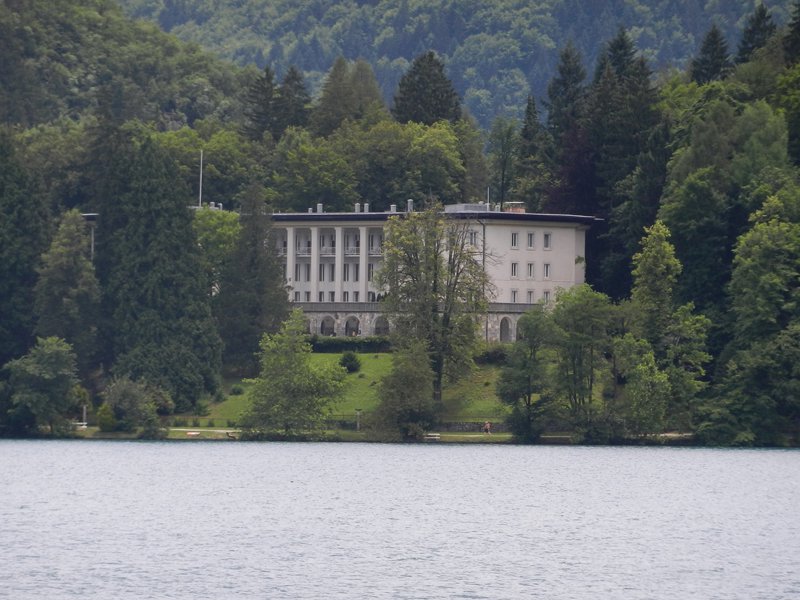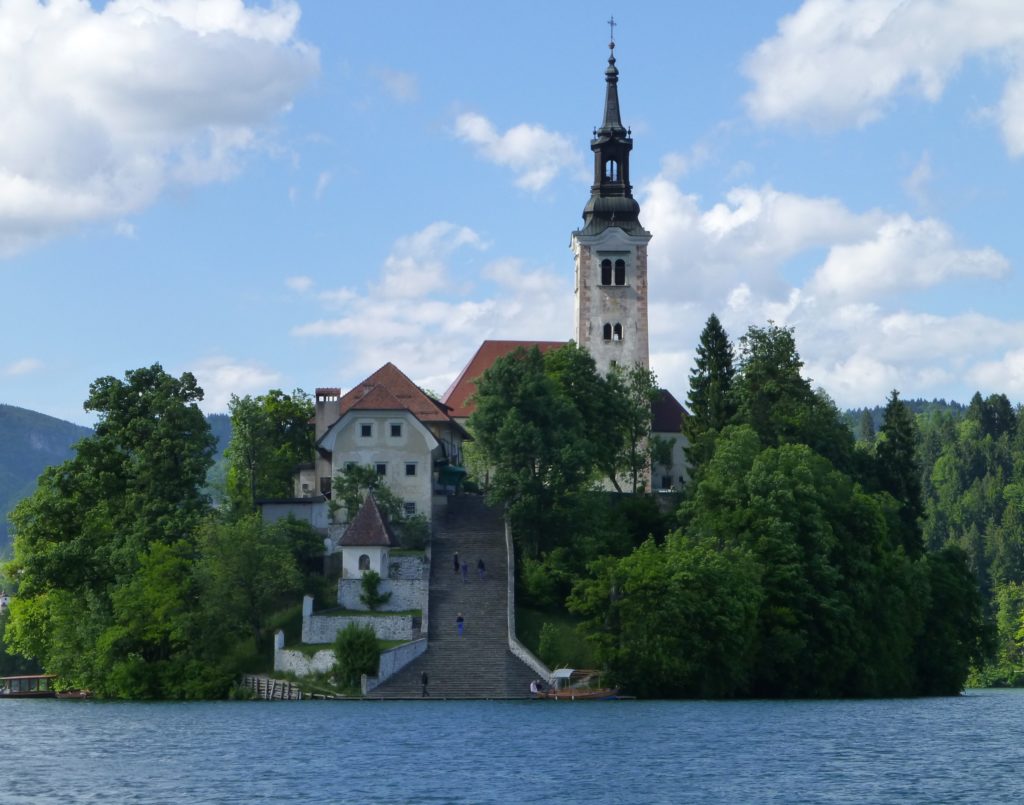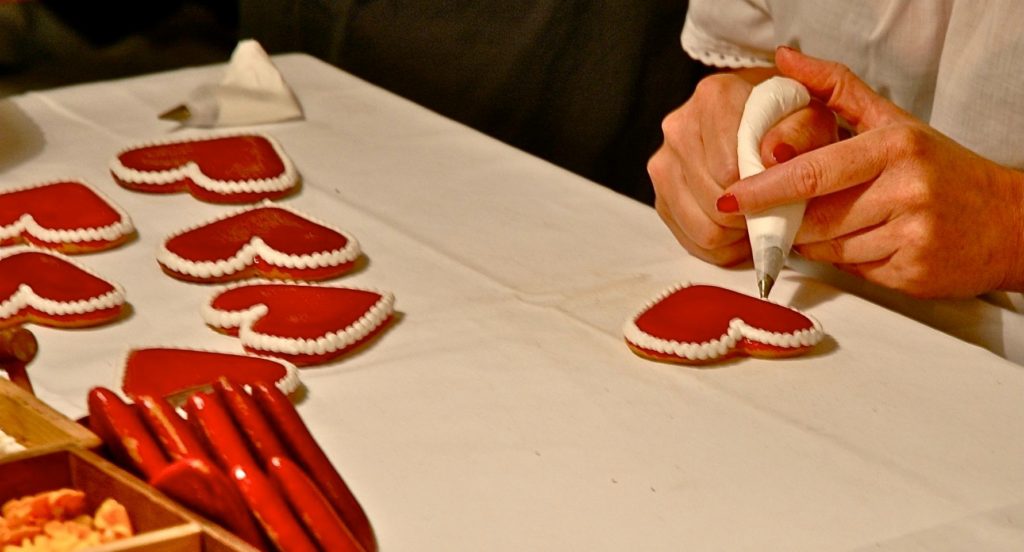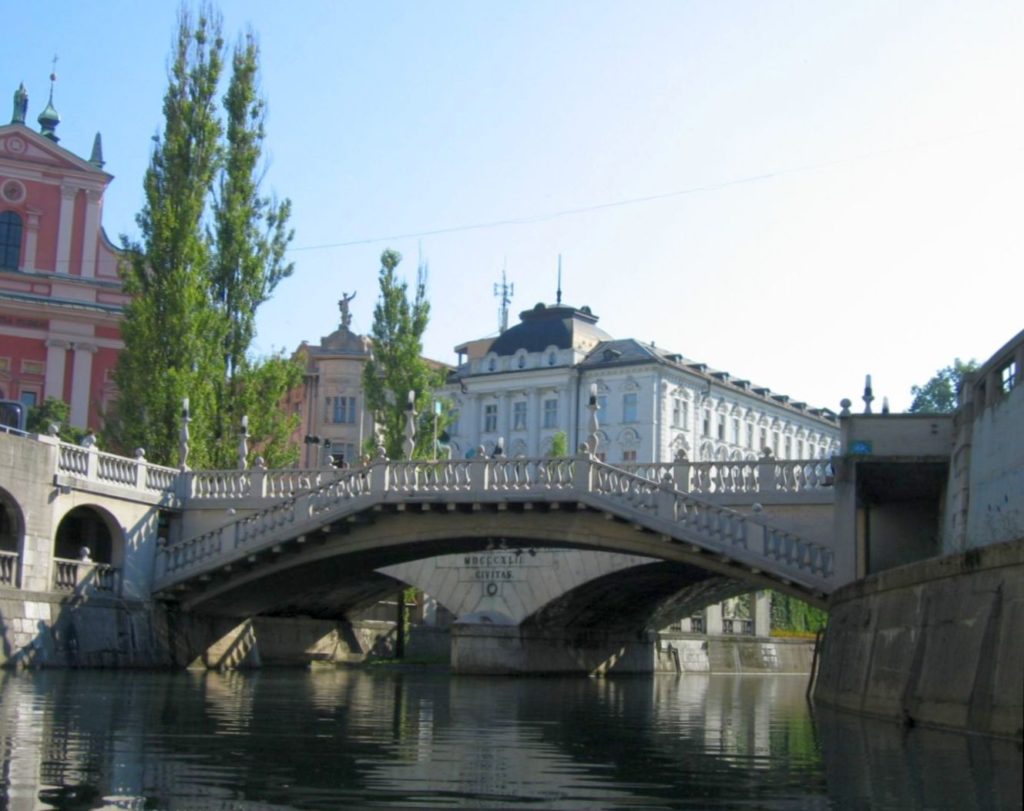Before we reached the island, Damir pointed out one of the buildings visible from the lake as we crossed it. Although he was a determined and devout communist, Marshal Tito wasn’t immune to enjoying some of the benefits of being powerful. Tito believed he should have a residence in each of the Yugoslav republics so, when he decided he needed a summer home, he looked around and, perhaps seeing that Bled had been the traditional home for Karađorđević royalty including the last King of Yugoslavia Peter I, he built this “modest villa”
in 1947 on the shore of Lake Bled. It’s now a hotel.
In the panoramas of the lake and island above, you doubtless spotted the tower and spire of the Assumption of Mary Pilgrimage Church. To reach the church, you have to march up this 99 step Baroque stairway (dating from 1655)
and if that’s not enough exercise for you, I’m told you can also climb to near the top of the 52-meter-high tower.
However, before there was a church, before the frescoes dating from the mid-15th century, the island had a temple dedicated to Živa, whose name means living, being or existing, and who is the Slavic goddess of life and fertility. France Prešeren (the poet whose name graces Ljubljana’s central square) mentions Živa in his epic-lyric poem The Baptism on the Savica. Perhaps a remnant of some ritual from these pre-Christian times gave rise to the present-day wedding tradition in which the husband carries his new bride up these steps while the bride remains silent. Then again, perhaps not.
Another tradition, particularly for visitors, is the ringing of the church bell. Some say it’s done for luck. Others that the act will grant a wish. I am a believer in neither luck nor wishes but was happy to help Judy chime out and hope that my cynicism didn’t cancel whatever wish she might have made.
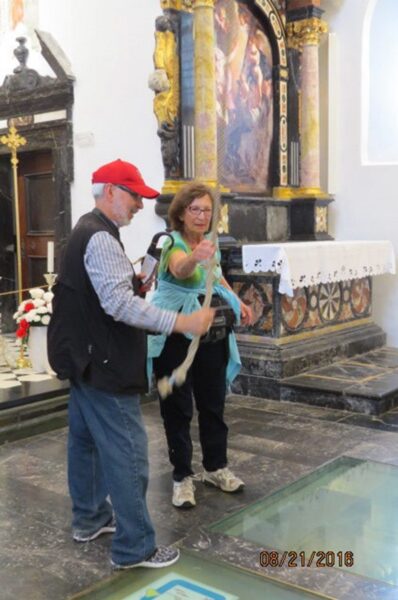
Those of you who’d like a more extended Lake Bled experience can watch this video.
It’s a bit over seven minutes long and continues with parts two and three. As for us, the time had come to get out of Bled and return to Ljubljana.
On our way, however, we stopped for lunch in the picturesque town of Radovljica. (At this moment I’m again grateful to Pat for sharing her photos with me because, while the cryptic notes I made about the pictures I took did nothing to stimulate my memory of this, her photos did.) We had a traditional lunch at the Gostilna Lectar which, as you can see in the photo is also a museum (muzej).
is also a museum (muzej).
Lectar is the Slovenian word for gingerbread and in the cellar of the 500-year-old building is a living museum where, in 1766, they added baking gingerbread to their mead and candle making workshop. This is a living museum because not only does someone explain the process,
you observe the steps involved in producing the traditionally heart shaped gingerbread from scratch from making the dough
to its decoration
to a finished product.
At lunch, we also got a little show when a family, who looked to be celebrating the birthday (or as I prefer to call it ‘birthaversary’) of their matriarch came into the restaurant as we were finishing up. An accordion player appeared and began playing a tune unfamiliar to me but all the men took turns dancing with her.
Bridges, darkness and whimsy.
By the time we returned to Ljubljana, I’d decided I wanted to spend some time exploring the city on my own but had no particular destination in mind. We’d again had a late-ish lunch and I sensed I’d want a light dinner so that also fit nicely with my plans to have a bit of a wander.
Like many European cities, Ljubljana has a large pedestrian only zone. There are also many streets, such as the one outside our hotel, that permit limited vehicular traffic. Much of the pedestrian zone is in the Old Town just across the Triple Bridge on the east side of Prešeren Square and which, like the square, is a central meeting point in the city. Here’s a wonderful perspective from the website of the Hotel Park:
There has been a bridge at or near this site since the 13th century and it’s had many different names across the centuries. Not surprisingly, the original bridge was wooden and it was long called Stari most or Old Bridge (but you doubtless recognize that appellation from reading about the bridge in Mostar). When a new crossing was built farther up the Ljuljanica River, people also began to refer to it as the Lower Bridge or Spodnji most. In the 14th century people began to call it Špitalski most for a poor house that had been built nearby. The bridge burned and was rebuilt after a fire destroyed it in 1657.
In 1842, an Italian architect designed and built a new bridge that had two arches and a metal fence. (In the photo, you can see the two arches in the center span.) He named it Franz’s Bridge in honor of the Austrian archduke Franz Karl. There’s a Latin inscription just above the central pier between the two arches that translates as, “To Archduke Franz Karl in 1842 by the Town.”
By the 1920s, however, and long before the pedestrian zone was established, the bridge couldn’t accommodate the growing foot and vehicular traffic and had become something of a bottleneck. The famed Slovenian architect Jože Plečnik designed the bridge that we see today and seen here from the river level.
The balusters, of which there are 642, are among the signature aspects of much of Plečnik’s work. Although they’re not apparent in either photo, nearby there are shops, pubs and cafes lining both sides of the river that contribute to Ljubljana’s lively nightlife.
The Triple Bridge crosses the main flow of the Ljubljanica River at a point where its southern entry into the city turns to the east to rejoin an arm that runs to the east of Castle Hill. Farther downriver toward the northeast is the Dragon Bridge. Between those two is the practically named Butcher’s Bridge and some blocks upstream is the similarly practically designated Cobbler’s Bridge. Although neither features those professions today, their historical purpose is clear.
It’s the Butcher’s Bridge that drew most of my attention on this day. As I discovered several years ago on my train journey across Russia, it has become a common sight to see, in both Europe and some of the more westernized cities of Asia, bridges covered with locks usually placed by newlyweds to signal the permanence of their love. In Ljubljana, the Butcher’s Bridge serves this purpose. (The building you see on the right is part of the Plečnikove arkade so called because Plečnik designed the colonnade. The arcade spans much of the distance between the Triple Bridge and the Dragon Bridge. It’s considered the indoor part of the central market and is one of the city’s important shopping areas.)
However, while interesting, the locks weren’t the feature that drew most of my attention. Rather it was the sculptures by the contemporary Slovenian artist Jakov Brdar that cross and adorn either side of the bridge that are far more compelling. Open the next post to see them.
